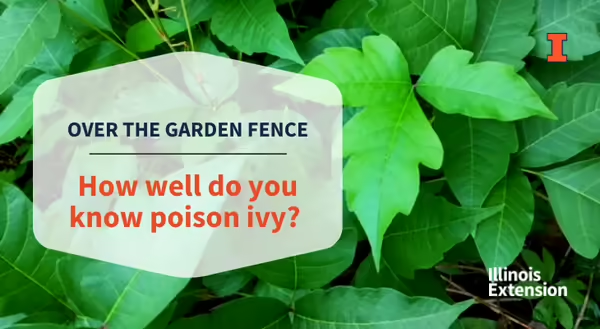
Experienced gardeners know where poison ivy is likely to be found in the home landscape, and what it looks like in its various forms and stages of growth. That may not be the case for newer gardeners or those having moved from an area relatively free from poison ivy to a wooded area or neighborhood. Without knowing it is in the yard, it is all too easy to get the oils on your hands and clothing while clearing beds of otherwise harmless weeds.
Until you can easily identify poison ivy, the adage “leaves of three, let it be,” are pretty good words to live by. Mature poison ivy provides birds the berries that later become seeds deposited along fence rows, beneath deciduous and evergreen tree canopies, and shrub borders.
Poison ivy seedlings
As a small seedling, it is not quickly recognizable and may look like many other immature weeds. This is one of the forms and stages we find poison ivy, just a typical weed in the garden. As they grow, the characteristic leaf trios begin to develop.
Poison ivy vines
As the seedling continues to grow, it moves to a vining growth habit for its next form, with the leaves clearly looking like all the pictures we see. As a vine it easily can be hiding in a bed of ground covers, reaching out into the lawn from the edge of the woods, or climbing up the house wall with the Boston ivy or other ornamental vines. Gardeners also will find it while pruning their shrubs.
Poison ivy and trees
When the poison ivy vine runs into a tree trunk then the third form shows up as vine that can cling to the bark using brown aerial roots. This form as a vine climbing the tree becomes the mature stage, where well up in the tree canopy, it has very large leaves, again with the typical three leaflets, but those leaves may be two feet in size. Besides the gigantic leaves, this is where the vine begins to flower and fruit annually. Poison ivy has outstanding reds and oranges for fall color and is quite attractive. Just remember, look and don’t touch.
Control and safety
In the home landscape removing poison ivy while small and before it begins to vine is best. It is the oil in the plant that gives us the dermatitis; watery blisters are common. Young seedlings will die if pulled out and left to dry, handling them as little as possible. You can use a digger of your choice, so you do not come in contact with the plants. Wearing an unlined rubber glove is a good idea too. With plants slightly bigger, gardeners could use a glyphosate product, but very carefully around valuable ornamentals. (And always read and follow label instructions and safety measures).
If you find yourself with one of those vines up the tree, carefully cutting through the vine at the soil line is the best option. Do not remove the vine; just leave it there to dry in the tree. No need to pull it down. Treat that vine stump too. Vines growing up the tree can be as small as a quarter of an inch to more than 3 inches in diameter for a larger mature vine.
All parts of poison ivy can give you dermatitis, and you can get a reaction even in the winter when plants and vines are dormant. NEVER burn poison ivy, as the oils will be in the smoke.
About the author: Richard Hentschel’s expertise extends across several subject areas with specialties in lawn care, fruit tree production, woody ornamentals, and home and community gardening. During his 45-year career in horticulture and agriculture, Hentschel became a well-known and respected expert for commercial and homeowner audiences, industry organizations, and media. He retired from University of Illinois Extension in April 2022 with nearly 30 years of service as a Horticulture Specialist and Educator in northern Illinois.